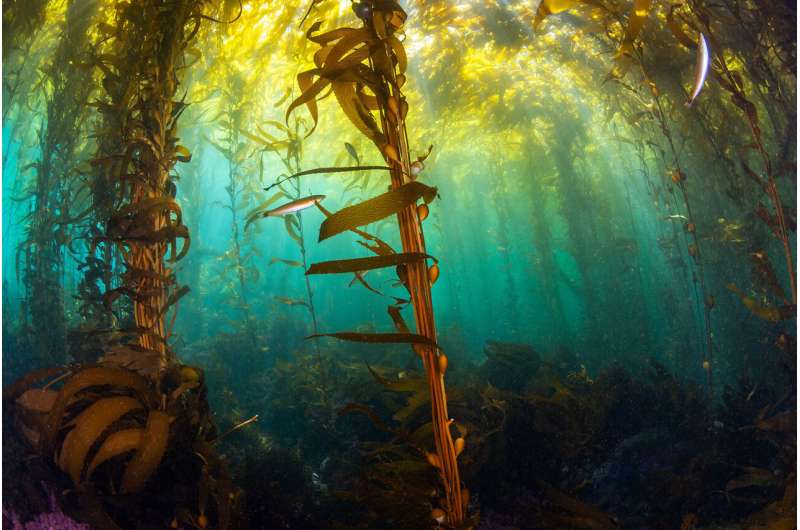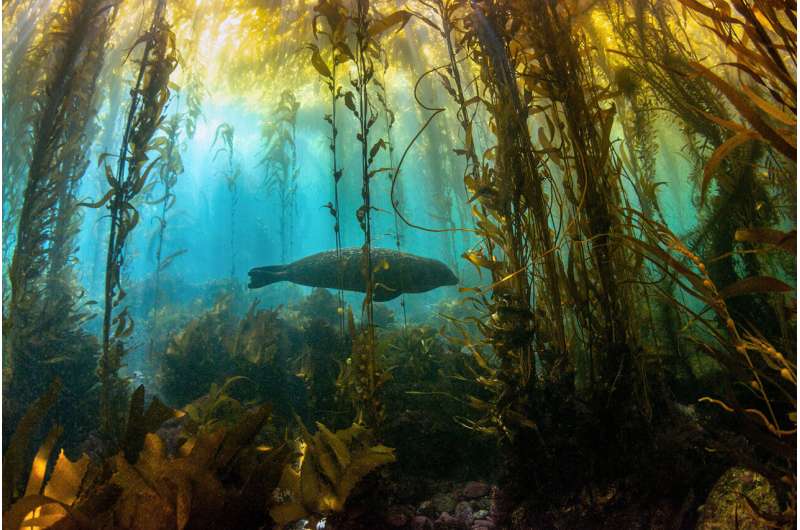This article has been reviewed according to Science X's editorial process and policies. Editors have highlighted the following attributes while ensuring the content's credibility:
fact-checked
peer-reviewed publication
trusted source
proofread
Designing marine protected areas in the fight against climate change

An international team has developed the first comprehensive framework for designing networks of marine protected areas that can help vulnerable species survive as climate change drives habitat loss.
In a paper published in One Earth, the researchers outlined guidelines for governments to provide long-distance larval drifters, like urchins and lobsters, as well as migratory species, like turtles and sharks, with protected stopovers along coastal corridors.
Led by Stanford marine conservation scientist Nur Arafeh-Dalmau, the team included 50 scientists and practitioners from academia, conservation organizations, and management agencies from the U.S., Mexico, and Australia.
The guidelines come at a critical time as nearly every country in the world has committed to protect 30% of land and sea by 2030. Marine protected areas and similar conservation measures on land connect habitats fractured by generations of human development or erratically carved up by wildfires and heat waves.
"Until now, marine protected areas have been designed for biodiversity conservation, but not necessarily for climate resilience," said Arafeh-Dalmau, a postdoctoral scholar in the Oceans Department at the Stanford Doerr School of Sustainability and an honorary fellow at The University of Queensland. "They suffer from climate impacts but aren't designed to endure them."
Enter the southern California bight
As a case study, the authors used the 21 biological and physical guidelines presented in their framework to map out protections for giant kelp ecosystems and species across the Southern California Bight. This vast region is distinguished by a gradual bend in the southerly trajectory of California's coastline where it curves to the southeast along the peninsula of Baja California, Mexico.
Here, giant kelp forests provide nursery areas, shelter from predators and storms, and food to hundreds of commercially and culturally valuable species. In recent years, marine heat waves and prolonged periods of low dissolved oxygen have led to the collapse of commercially valuable fisheries like jumbo squid and abalone, jeopardizing the livelihoods of local communities.
Though Baja California is home to large marine protected areas and in the process of designing more, less than 1% of coastal waters are fully protected and prohibit extractive activities like fishing or drilling. In California, marine protected areas comprise 16% of state waters, half of which are fully protected. According to the California Department of Fish and Wildlife, these protected waters make up the largest ecologically connected marine protected area network in the world.
However, the network doesn't account for how species move between the U.S. and Mexico, which means even if one country protects species' nurseries, those benefits are lost if protections end a short drift into the neighboring country where larvae might settle and grow into adults.
"We designed a systematic approach to help resource managers stay ahead of the curve and anticipate rather than react to climate change," said co-lead author Adrian Munguia Vega, a genomics researcher at The University of Arizona and the Applied Genomics Lab in Mexico.
"A big part of that is showing how entire marine ecosystems and the species that inhabit them are connected by ocean currents that do not stop at the international border. Thus, we need coordinated efforts and protections across political boundaries."

Integrating climate
Government agencies charged with establishing new marine protected areas typically refer to biological and physical criteria developed by scientists over the past two decades. The study authors expanded these guidelines from acknowledging the need to address climate adaptations to explicitly planning for how various future climate scenarios might play out.
For example, conservation planners today try to provide enough time for threatened species to recover from overfishing or habitat loss before allowing extractive or harvesting activities, but few models have considered how worsening marine heat waves will lengthen that recovery period. The new framework requires marine resource managers to evaluate whether proposed timelines will facilitate recovery of vulnerable species over the next decade or even century.
Management authorities also currently consider whether protected areas include the full range of habitats that regional species need to thrive. In the Southern California Bight, they might prioritize conserving a variety of sandy beaches, tidal flats, rocky reefs, and kelp forests. In addition to habitat diversity, the researchers prioritized habitat persistence or a habitat's presence over time.
Considered "climate refugia," these habitats often experience natural temperature swings from local currents and can provide consistent relief for species faced with extreme thermal shocks.
"Climate extremes don't stop at the boundary of a marine protected area," said co-author Fiorenza Micheli, chair of the Oceans Department and co-director of the Center for Ocean Solutions. "If California's network of marine protected areas had been designed with climate considerations, it would look different."
Putting the framework into practice
The researchers examined decades of satellite imagery to map giant kelp persistence along 1,678 miles (2,700 kilometers) of continuous coastline in the Southern California Bight and quantify how many safe havens they provide for larvae spawned by sea cucumbers, sea urchins, abalone, and California sheephead.
They found that under current protection schemes, marine heat waves expected over the next 50 years will splinter the suitable habitat for these larvae. The authors estimate ecological connectivity, a measure of the animals' ability to move freely from place to place, will fall by about half, while population density could decline by as much as 90%. This would mean smaller gene pools and greater risk of population collapse.
Conventional assessment methods prioritize protection of areas that have the greatest number of kelp species. The new framework, by contrast, identified sites where kelp have the highest chance of survival and are more likely to provide a stable habitat for other marine species to reproduce. They recommended a series of protected areas that link isolated populations like beads of a necklace along the Southern California Bight.
"This stepping stone strategy can be very cost-effective and cheaper for everyone," said Arafeh-Dalamu, who documented Mexico's worst marine heat wave from 2014 to 2016. "Maybe you need fewer areas to be protected if you are protecting the important areas." Plus, he added, the collaboration between countries can strengthen research capacity, and ideally, diplomacy.
"We have the information and tools to design and implement marine conservation in a way that explicitly and proactively accounts for climate change," said Micheli. "Now is the time to understand where we strategically invest in expanding and strengthening protection so these ecosystems have a future."
More information: Nur Arafeh-Dalmau et al, Integrating climate adaptation and transboundary management: Guidelines for designing climate-smart marine protected areas, One Earth (2023). DOI: 10.1016/j.oneear.2023.10.002
Journal information: One Earth
Provided by Stanford University




















